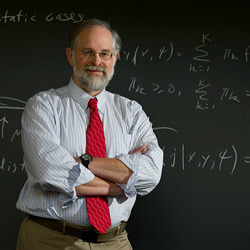

Steven Buechler, professor in the Department of Applied and Computational Mathematics and Statistics, notes that having applied and computational mathematics and statistics in one department is uncommon, but fits well with the importance of computation in both fields. Also, breakthroughs in biology, medicine and technology often require both applied mathematics and statistics. “You have these different perspectives coming together to solve the problems and having them in one department is very useful,” said Buechler. Forming this department reflects Notre Dame’s commitment to tackling big problems for humankind.
In this video, Buechler introduces Notre Dame researchers—including some outside of ACMS—whose collaborative work in developing computational models is an outgrowth of significant University investment in faculty hiring and is advancing research in global health, hospital biofilms, and the diagnosis and treatment of complex forms of cancer.
The featured faculty include M. Sharon Stack, Ann F. Dunne and Elizabeth Riley Director of the Harper Cancer Research Institute; Mark Alber, Vincent J. Duncan Family Professor of Applied Mathematics; and Fang Liu, Huisking Foundation Assistant Professor of Applied Computational Mathematics and Statistics.
To watch the video, which is part of the Advancing Research series, and learn more about ACMS research at Notre Dame, please click here.
The University of Notre Dame is a private research and teaching university inspired by its Catholic mission. Located in South Bend, Indiana, its researchers are advancing human understanding through research, scholarship, education, and creative endeavor in order to be a repository for knowledge and a powerful means for doing good in the world.
Originally published by Amanda Skofstad at international.nd.edu on April 01, 2016.